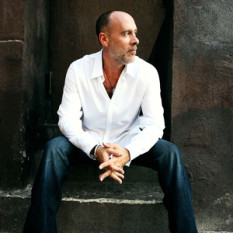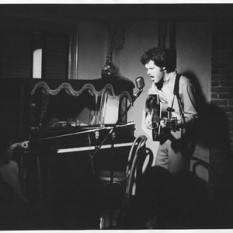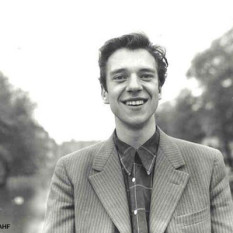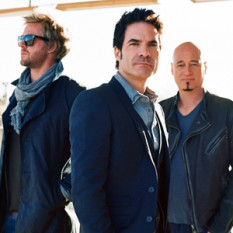VENICE
Kipp Lennon, lead vocals
Mark Lennon, lead vocals
Michael Lennon, producer, acoustic and
electric guitars, bass, keyboards, vocals
Pat Lennon, acoustic and electric guitars, vocals
“Venice is the best vocal group in America right now. They're better
than anybody else I know. They're fantastic. I’m a student of harmony.
That’s my thing. I love all kinds of harmony. But I particularly love
theirs, because it’s so natural. It’s not like anybody else’s. Very
unforced, very from their hearts. I’ve been telling people about them
since the first night I heard them. I’ve told everybody I could find that
they were the best. This is my favorite band in the world.”
--David Crosby
"Venice, one of my favorite bands, is quintessentially Californian, with
soaring harmonies. We’ve played together at numerous benefits and at
each other's concerts. What they do is sing amazingly. There are two
lead singers, there are four harmony parts a lot of the time, and what it
most resembles is CSN, or sometimes Sly and the Family Stone. Well,
anything unique is pretty hard to describe, but that's the general musical
terrain. They sing and play their asses off, and I have seen them knock
out many an unsuspecting crowd. On two separate occasions I booked
them for large outdoor venues where we were doing benefits and they
took the audiences, who had not come to see them, completely by
surprise. It's such a pleasure to play with these guys, because they
have that power."
--Jackson Browne
In November of 2005, Venice began writing for their tenth studio album. This time, they
had a very specific direction to guide their creative energies. They had recently signed
with Universal Records, who had released their biggest selling album to date, “Two
Metre Sessies,” and the label loved the intimate mood of that album and the mellow side
of the band that it represented. So they asked Venice to essentially come up with “Two
Metre Sessies Part 2,” only with new material this time (as that album had been a
greatest hits set).
Because “Two Metre Sessies” is a collection of songs that Venice performed live during
the taping of the television program of the same name, all of the tracks had been
recorded with the whole band playing together at the same time. This created a feeling
of immediacy and presence that both the band and the label agreed has been missing
from Venice’s previous albums. So it was decided that in order to maintain the “Two
Metre Sessies” feel, this new studio album should be recorded the same way: Live.
Kipp Lennon explains the overall concept. “We wanted it to be spontaneous and loose
and no overdubbing or fixing wherever possible. Mellow and moody, but also fun and
energetic along the way.”
So the band began to collaborate. First during frequent writing trips to “Hideaway Hill”
(their family home in Vista, California), and then later at each other’s houses in between
family responsibilities.
For Michael Lennon, the knowledge that they would be recording this album live in the
studio brought a freshness to the writing process. “In a sense,” he says, “the songs had
to be great in their simplest form. We knew we couldn’t rely on fancy production to make
them shine. They would have to survive with one guitar or one piano and vocals.”
Once the new batch of songs were developed enough to start playing, the rehearsal
process began. Every song had to be as finished and tight as possible by the time they
got into the studio, so rehearsing for the recording sessions was very similar to the
process of rehearsing for a tour.
Explains Michael, “This rehearsal process really enriched the songs. Having musicians
that you really respect to bounce ideas off of is invaluable. Even if someone’s idea
doesn’t work, it often triggers another idea that does.”
In the first week of May, 2006, two weeks prior to the scheduled recording start date,
Venice began an 11th hour cram session. Dutch keyboardist Nick Bult flew to California,
where he, the four Lennons, bassist Mark Harris and drummer Jamie Wollam spent an
intensive week at Michael’s guest cottage fine-tuning the new songs together as a band.
It was long days and hard work, but Mark Lennon also remembers the fun. “We
laughed, ate, drank and worked out all the arrangements together in a relaxed
atmosphere,” he says.
After Nick returned home, the band continued to massage the songs right up until
stepping onto the Holland-bound plane one week later. Then on May 18th, recording for
the album began. Their studio was de Singelkerk, an old wooden church in Amsterdam.
Why a church instead of a traditional recording studio? Michael explains, “The room
itself has a beautiful natural reverb that, when controlled, is amazing sounding. Also, the
old wooden construction, the wood plank floors and the leaded glass windows gave it a
very warm feel.”
Mark recalls the atmosphere. “Three stories high, it had a great acoustic sound that we
took advantage of. They had a reception/kitchen/office area where we made our tea and
checked our e-mails. There was another room we used for our huge group lunches and
dinners where we rarely talked about the recordings and just took a real break and
laughed at each other’s funny stories and stupid jokes.”
The band’s original idea had been to record the music and the vocals at the same time,
but due to technical limitations, they were only able to do that with three songs, “Ashes
in the Snow,” which is on the main album, and “We’re Okay” and “Katrina,” which are on
the bonus CDs. For everything else, they were forced to change their game plan. They
wound up recording all of the music first, with the band set up on two-foot-high stages, in
a circle, facing each other. Kipp and Mark stood outside in the hallway singing reference
vocals into microphones that could only be heard in the musicians’ headsets. Individual
mics were placed in front of each instrument, and then ambient mics were set up around
the room to capture the blended sound of the band as they played together.
Once all the music was laid to tape, the instruments were cleared from the room, and it
was time to record the vocals. New stages were built, six feet high this time, and they
were again arranged in a circle, facing each other. Once again, ambient mics were set
up around the room, to augment the signals from each vocalist’s large vocal mics.
According to Michael, “The lead vocalist would sing his part at the same time we would
sing the background parts. The pressure was on not to screw up the other guy’s take,
but it felt so good to sing together in one room at one time!”
Because the band was so well prepared, they wound up cutting 18 tracks in only 10
days. No small accomplishment considering they had to keep tearing down their entire
setup to allow for regular church functions. But Michael believes that working so quickly
really made the music come to life. “It’s not always ideal to make a record in this short
amount of time,” he explains, “but I think that’s when people really deliver. In the end, it
keeps a raw, imperfect vibe that adds energy to the final project. Time restraints keep
you from over-thinking and over tweaking things. You’re forced to rely on your gut
instead of all the little voices in your head that are telling you ‘Maybe this’ or ‘Maybe
that.’ “
“It felt like we were making an album in the 60's or 70's,” Kipp adds, “when you just dove
in and cranked out an album. We were lucky that we didn't have enough time to get too
picky about anything, spending hours overdubbing to make it ‘perfect,’ which can end up
sounding sterile and lifeless. We also have noticed throughout the years that all of our
favorite albums by other artists -- huge, historic influential artists -- have lots of little
imperfections in pitch and performance, but it was the overall vibe that grabbed the
audience. The song. The energy. So we strove to not beat up our performances too
much. We would say ‘Rock and roll...’ and move on. It was liberating in a way.”
Michael continues, “Although at times it was a bit stressful and uncomfortable, the
experience of playing together as a band was awesome. When five musicians are
laying down a track and you make a mistake on your part that ruins the other guy’s
greatest take, that’s the down side. However, when someone plays a new part that
wasn’t in the take before and that triggers another guy to play a new part and suddenly
we’re in uncharted territory, that’s exciting. It doesn’t always work, but the journey is
amazing and most of the time it lifts the track to a whole new level. There’s something
great that comes out of musicians when they are put in that ‘do or die’ situation that
cannot exist when they know that you can just push stop, rewind a bit, and punch in
again before their mistake.”
One of the highlights of these sessions was the day (May 23, to be exact) when they
were accompanied by ten string players on the songs “Too Late for Me Now” and “Ashes
in the Snow,” plus the bonus CD’s “We’re Okay.” When the string musicians arrived,
many were surprised to learn that they would be performing live with Venice, because
their typical process is to play to a pre-recorded track.
Michael remembers, “Although it was our dream to have live strings on the album, I was
a bit apprehensive when the day came to record those three songs. But the moment
they started running through the arrangements, I looked over at Pat and he had tears in
his eyes, as did I. It’s one thing to hear strings on a record, but to stand in front of ten
live players who are playing a song that Kipp and I wrote was one of the highlights of my
career.”
Adds Mark, “The string section brought an elegance, a richness and a unique feeling
that only a live orchestra can bring. It’s funny, but every time we’ve had any kind of
orchestration with any recordings or concerts we’ve done, we all end up crying and
hugging each other with tears of joy, because not only are we lucky to have them there,
but the chords and notes they end up playing on our stuff always seem to be exactly
what we would have written. Everything reminds us of our favorite movies that had
similar soundtracks that made us cry and shaped a lot of who we are musically today.”
The band decided to name to new album after the city they’d recorded it in,
“Amsterdam.” Kipp explains, “Michael said he liked the idea of calling it ‘Venice in
Amsterdam’ because it was cool sounding. You know, the two city names. And
because we were recording it there and we have spent so much time in Amsterdam over
the last seven years, in some ways it is like our other home town. Then we thought that
title might confuse some people because it sounds like a live album, so we just
shortened it to ‘Amsterdam,’ which we all loved. It's also cool because the Beach Boys
once recorded an album in the Netherlands called ‘Holland.’”
The title holds a special meaning for Mark. “To me, Amsterdam is a European mirror of
our city of Venice, California, in a lot of ways. Artistic, free, and a melting pot of all
cultures and lifestyles. Kind of like our music!”
Kipp agrees. “There is a certain vibe that is particular to that city that we all love.
Beyond the obvious cliché image people have of Amsterdam as a legalized pot zone
and red light districts, there is a beautiful, vibrant, old city with a proud history and
culture. Artistic, historic, mellow and alive. Modern and traditional. Similar to Venice
beach, but they've got us beat by about 500 years or so.”
The band flew back home to America at the end of May, but in the following few weeks,
in between local California Venice gigs, Michael returned to Holland twice to oversee the
album’s mixing. The final result is a new collection of songs that is near and dear to the
band’s heart.
“When I listen to this album” says Mark, “it feels like I’m seeing a private, live show in a
great sounding room.”
“To me,” he summarizes, “There is no one way or only right way to do an album. You
just try different things and celebrate that time in your recording career. Have fun while
doing it, and look forward to surprising yourself on the next recording venture.”
.
Alle Alben
Sie können Informationen über die beste Musiksuchmaschine finden - Muzlan.top 😊Alle Materialien auf Anfrage "Venice" finden Sie auf Seite Venice
Ja natürlich. Sie können Titel auf der Seite Venice anhören
Ja natürlich. Sie können Titel auf der Seite Venice herunterladen
Diese Seite wird durch Abfragen gefunden: Venice track minus, Venice all mp3, Venice mp3 download, Venice flac, Venice song download




